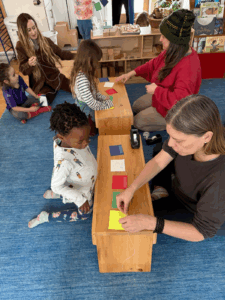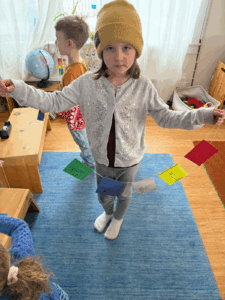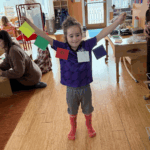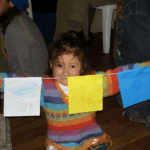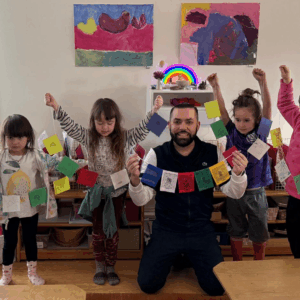Create your own Tibetan Prayer Flags
About This Resource
Details
Contributor
Adapted by Carlo Carranza
- Duration: 1–1.5 hours
- Ages: 5+
- Teacher/Student Ratio: 1:5
Big Ideas
- Good intentions can be shared with the world through art.
- Prayer flags are a traditional way to offer blessings of kindness, joy, and peace.
- Creating art mindfully is a form of practice and reflection.
Materials
- Five sheets of paper per student in these colors: blue, white, red, green, yellow
(these represent the five elements in Tibetan tradition) - Crayons, markers, or colored pencils
- String or yarn (about 3–4 feet per student)
- Stapler or tape
- Hole punch (optional)
- Sample prayer flags for inspiration (optional)
Teacher Prep
- Pre-cut paper into rectangles (approx. 6×8 inches)
- Prepare examples and images of real Tibetan prayer flags
- Hang one completed flag set as a demonstration
- Review basic symbolism or meaning behind the five colors (optional)
Introduction to Prayer Flags (5–10 minutes)
Gather the students and say:
“Now we’re going to do something special. Have you ever seen colorful flags hanging in the wind? These are called Tibetan Prayer Flags. The purpose of prayer flags is to spread good wishes, like love, kindness, and joy, out into the world. When the wind blows, it carries your wishes to all people and places!”
What’s on Prayer Flags (5–10 minutes)
Explain:
“Prayer flags often have special messages or drawings that remind us of good qualities like love, wisdom (intelligence), joy, and compassion. These help us remember to be kind. Some people also include personal wishes—for their family, friends, or the whole world.”
Instructions (30–45 minutes)
Each student will create five flags, one for each theme:
- Love – draw a heart or someone giving a hug
- Wisdom/ Intelligence – a candle or book
- Compassion – two hands holding each other or someone helping another
- Joy – a sun or smiling face
- Personal Wish – a picture or words about something you want for someone you love
“Use bright colors, take your time, and draw what these ideas mean to you. Write your wishes, too, if you like!”
Assembly (10–15 minutes)
- Help students staple or tape their flags in a row onto a string
- Optional: use a hole punch and loop the paper over the string
- Let students take the flags home or hang them in the classroom
Closing Inspiration (5 minutes)
Gather in a circle and say:
“As we hang these flags, imagine your drawings and words spreading happiness and love. Every time the wind moves them, your wishes travel across the world. This is a beautiful way to share your good heart with others.”
Encourage them to look at each other’s flags and feel proud of the good intentions they’ve created.
Differentiation
- Younger students (ages 5–7) can focus on drawing only, without writing
- Older students (ages 8–12) can include thoughtful words or sentences
- Early finishers can help decorate the string, borders of the flags, or write wishes in other languages
